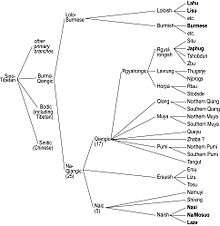Naic languages
The Naic or Naxish languages are a group of Sino-Tibetan languages that include Naxi, Na (Mosuo), Shixing (Xumi), and Namuyi (Namuzi). They have been variously classified as part of the Loloish or the Qiangic branch of Sino-Tibetan.
| Naic | |
|---|---|
| Naxish | |
| Geographic distribution | Yunnan and Sichuan |
| Linguistic classification | Sino-Tibetan
|
| Subdivisions | |
| Glottolog | naic1235[1] |
The name "Naic" is derived from the endonym Na used by speakers of several of the languages.
Classification
Lama (2012)
Lama (2012) lists the following languages in his Naxish clade, which he places in the Loloish branch.
Lama (2012)[2] lists the following sound changes from Proto-Loloish as Naxish innovations.
- *sn > ȵ-
- *pw- > b-, ʁ-
Jacques & Michaud (2011), Bradley (2008), Chirkova (2012)
The Naic group (corresponding to Lama's Naxish clade) is classified as Qiangic and not Loloish by Guillaume Jacques & Alexis Michaud (2011).[3] David Bradley (2008) has also suggested that the Naic group of languages (including Naxi, Na, Namuyi, and Shixing) are Qiangic languages.[4]

The argument is based on the discovery of cognates with Qiangic languages, that are superficially undetectable due to the high degree of phonological erosion of the Naic languages, but can be uncovered through a systematic examination of lexical correspondences. Progress in the reconstruction of rGyalrongic languages and other languages of the Qiangic branch offers an improved basis for reconstruction. For instance, it appears that Proto-Naish *-o corresponds both to Proto-Rgyalrong *-o and *-aŋ, suggesting a merger between a closed syllable and an open syllable.
Chirkova (2012)[5] confirms that "Shixing displays significant similarity with Na [i.e. Naish] languages in all its linguistic subsystems and no comparable similarity with any other local language or group of languages" (p. 154). From a detailed comparison, the author concludes that "Shixing can be hypothesized to be a Na language that has undergone considerable restructuring" (p. 157).
Lidz (2010)
Lidz (2010)[6] groups the Naxi varieties as follows, but does not consider where these languages fit within Sino-Tibetan. Lidz notes that the western groups call themselves "Naxi", whereas the eastern groups call themselves "Na" — hence the parentheses. Lidz (2010) also notes that the Na (Eastern) speakers of Sichuan are officially classified as ethnic Mongols by the Chinese government. Namuyi and Shixing are not addressed.
- Na(xi)
References
- Hammarström, Harald; Forkel, Robert; Haspelmath, Martin, eds. (2017). "Naic". Glottolog 3.0. Jena, Germany: Max Planck Institute for the Science of Human History.
- Lama, Ziwo Qiu-Fuyuan. 2012. Subgrouping Of Nisoic (Yi) Languages: A Study From The Perspectives Of Shared Innovation And Phylogenetic Estimation. Ph.D. dissertation, University of Texas at Arlington.
- Jacques, Guillaume, and Alexis Michaud. 2011. "Approaching the historical phonology of three highly eroded Sino-Tibetan languages: Naxi, Na and Laze." Diachronica 28:468-498.
- Bradley, David. 2008. The Position of Namuyi in Tibeto-Burman. Presentation at the Workshop on the Namuyi language, Taipei, 2008.
- Chirkova, Katia (2012). "The Qiangic Subgroup from an Areal Perspective: A Case Study of Languages of Muli." In Languages and Linguistics 13(1):133-170. Taipei: Academia Sinica.
- Lidz, Liberty A. 2010. A Descriptive Grammar of Yongning Na (Mosuo). Ph.D. dissertation. Austin: University of Texas, Austin.